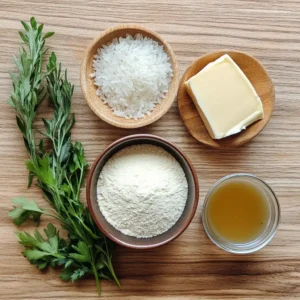Introduction
Why Gluten-Free Gravy Matters
Gravy is the perfect finishing touch for a turkey dinner, adding richness and flavor to the meal. However, traditional gravy recipes often contain wheat flour as a thickener, making them unsuitable for individuals with gluten sensitivities or celiac disease. As a result, gluten-free turkey gravy provides a safe and delicious alternative, ensuring that everyone at the table can enjoy this classic comfort food without worry.
Benefits of Gluten-Free Turkey Gravy
Making your own gluten-free turkey gravy has several benefits:
- Customizable Ingredients: By preparing it yourself, you can ensure every component is gluten-free and tailored to your taste preferences.
- Safe for All Diets: Gluten-free gravy allows people with dietary restrictions to enjoy a staple of holiday meals.
- Rich and Flavorful: With the right techniques, gluten-free gravy can be just as creamy, savory, and satisfying as traditional versions.
Essential Ingredients for Gluten-Free Turkey Gravy
Gluten-Free Flour Alternatives
To make gluten-free turkey gravy, the thickener is key. Traditional wheat flour is replaced with gluten-free alternatives that provide a smooth, lump-free consistency. Popular gluten-free options include:
- Rice Flour: Produces a smooth, consistent texture without affecting flavor.
- Cornstarch: Works quickly and gives a glossy finish.
- Tapioca Flour: Ideal for achieving a light, smooth consistency.
- Potato Starch: Adds thickness while maintaining a creamy texture.
Broth and Drippings: The Flavor Foundation
The flavor of your gravy depends on its base ingredients:

- Turkey Drippings: The rich juices left in the roasting pan are packed with savory flavors.
- Broth or Stock: Supplement the drippings with turkey or chicken broth for the perfect liquid base.
- Seasonings: Salt, pepper, garlic powder, and herbs like thyme and rosemary enhance the natural turkey flavor.
Optional Additions for a Gourmet Touch
To elevate your gluten-free gravy, consider adding these optional ingredients:
- Wine: A splash of white wine or sherry can add depth and complexity.
- Cream or Coconut Milk: For a creamier texture, stir in a few tablespoons of heavy cream or dairy-free alternatives.
- Fresh Herbs: Chopped parsley, sage, or thyme can bring a burst of freshness to the dish.
Step-by-Step Instructions for Gluten-Free Turkey Gravy
Preparing the Turkey Drippings
Turkey drippings form the flavorful foundation of your gravy. Follow these steps to prepare them:
- Collect the Drippings: After roasting your turkey, carefully pour the drippings into a heatproof container or fat separator.
- Separate the Fat: Allow the drippings to sit for a few minutes so the fat rises to the top. Skim off the fat and save it for making the roux.
- Supplement with Broth: If you don’t have enough drippings, add turkey or chicken broth to reach the desired amount of liquid.

Smooth and lump-free gravy being prepared step by step.
Making a Gluten-Free Roux
A roux is a mixture of fat and flour that serves as the base for gravy. For gluten-free gravy, the process is slightly different. Here’s how to make it:
- Heat the Fat: In a medium saucepan, heat 2–3 tablespoons of turkey fat or butter over medium heat.
- Add the Gluten-Free Flour: Sprinkle an equal amount of gluten-free flour, such as rice flour or cornstarch, into the pan while whisking constantly.
- Cook the Roux: Stir the mixture for 2–3 minutes to cook off the raw flour taste without letting it brown.
Incorporating Liquid and Adjusting Consistency
Once the roux is ready, it’s time to incorporate the liquid:
- Add the Liquid Gradually: Slowly pour in the turkey drippings or broth while whisking continuously to prevent lumps.
- Simmer to Thicken: Bring the mixture to a gentle boil, then reduce the heat and let it simmer for 5–7 minutes. Stir frequently to avoid sticking.
- Adjust the Thickness: If the gravy is too thin, mix a teaspoon of gluten-free flour with cold water to create a slurry, then whisk it into the simmering gravy. If too thick, add more broth gradually until the desired consistency is achieved.
Finishing Touches for Perfect Gravy
Taste the gravy and add final seasonings:
- Salt and pepper for balance.
- A splash of gluten-free soy sauce or Worcestershire sauce for a savory boost.
- Fresh herbs like thyme or parsley for an aromatic touch.
With these simple steps, you’ll create a rich, flavorful gluten-free turkey gravy that’s perfect for any occasion.
Tips for Perfect Gluten-Free Gravy
Common Mistakes to Avoid
Making gluten-free gravy requires some adjustments compared to traditional recipes. Here’s how to avoid common pitfalls:
- Choose the Right Flour: Not all gluten-free flours work equally well. Stick to rice flour, cornstarch, or tapioca starch for the best results.
- Control the Heat: Cooking the roux or gravy over high heat can cause it to separate or clump. Use medium heat for a smooth consistency.
- Add Liquid Gradually: Adding the liquid too quickly can create lumps. Pour it in slowly while whisking constantly to blend evenly.

Rich turkey gravy adds the perfect touch to your meal.
Preventing Lumps for a Smooth Texture
No one wants lumpy gravy! To ensure a silky texture, follow these tips:
- Make a Slurry: If using cornstarch or potato starch, mix it with cold water first to create a smooth paste before adding it to the gravy.
- Whisk Continuously: Keep whisking as you combine the roux and liquid. This prevents clumps from forming.
- Strain the Gravy: For a professional touch, strain the finished gravy through a fine mesh sieve to remove any small lumps.
Storing and Reheating Gluten-Free Gravy
To make your meal prep easier, you can store and reheat gravy without losing its quality:
- Refrigeration: Store leftover gravy in an airtight container in the refrigerator for up to 3–4 days. Reheat gently on the stovetop, adding a splash of broth to restore its consistency if needed.
- Freezing: Gluten-free gravy freezes well. Cool it completely before transferring to freezer-safe containers. It can be frozen for up to 3 months. Thaw in the refrigerator overnight and reheat slowly while stirring.
By following these tips, you can create a flawless gluten-free turkey gravy that’s smooth, flavorful, and sure to impress your guests.
Variations of Gluten-Free Turkey Gravy
Dairy-Free and Vegan Gluten-Free Gravy
For those avoiding dairy or animal products, you can create a delicious gravy that fits your needs:
- Use Plant-Based Butter or Oil: Replace turkey fat or butter with olive oil, avocado oil, or vegan butter.
- Choose Vegetable Broth: Substitute turkey or chicken broth with a rich vegetable broth for a flavorful base.
- Enhance Umami: Add a teaspoon of nutritional yeast, gluten-free soy sauce, or tamari for a deeper savory flavor.
Keto and Low-Carb Options
A keto-friendly or low-carb version of gluten-free gravy requires minor adjustments:
- Skip Starches: Use xanthan gum or guar gum instead of flour or starch for thickening. Add it sparingly to avoid an overly gelled consistency.
- Focus on Fats: Turkey drippings naturally contain zero carbs, making them perfect for keto-friendly gravies. Enhance with heavy cream for added richness.
Specialty Additions: Wine, Cream, and Herbs
To elevate your gluten-free turkey gravy for special occasions, consider these gourmet variations:
- Add a Splash of Wine: Deglaze your pan with white wine, sherry, or even red wine for a bold, sophisticated flavor.
- Incorporate Cream: Stir in heavy cream, coconut milk, or cashew cream at the end for a luxuriously creamy texture.
- Infuse with Herbs: Simmer the gravy with sprigs of thyme, rosemary, or bay leaves to enhance its aroma and depth.
With these variations, your gluten-free gravy can cater to diverse dietary preferences and add a unique touch to your meals.
FAQs
What’s the Best Gluten-Free Flour for Gravy?
The best gluten-free flour depends on your desired texture. For a smooth and silky gravy, rice flour and cornstarch are excellent options. Potato starch is ideal for a thicker, creamier consistency, while tapioca flour adds a glossy finish.
Can Gluten-Free Gravy Be Made Without Drippings?
Yes, you can make a flavorful gluten-free gravy without turkey drippings. Simply use a high-quality turkey or chicken broth as the base and enhance the flavor with aromatics like onions and garlic, fresh herbs, and seasonings.
How Long Does Gluten-Free Gravy Last?
When stored in an airtight container, gluten-free gravy can last:
- In the refrigerator: Up to 3–4 days.
- In the freezer: Up to 3 months. Thaw frozen gravy in the refrigerator overnight before reheating.
Can Gluten-Free Gravy Be Frozen?
Absolutely! Gluten-free gravy freezes well. To freeze, let the gravy cool completely and store it in freezer-safe containers or bags. Label them with the date, and be sure to leave some space for expansion.
How Do I Fix Lumpy Gluten-Free Gravy?
To fix lumpy gravy:
- Use a whisk to break up clumps while simmering.
- Strain the gravy through a fine mesh sieve for a perfectly smooth texture.
- Blend it with an immersion blender if lumps persist.
Can I Make Gluten-Free Gravy Ahead of Time?
Yes, making gravy ahead of time can save you stress during meal prep. Store it in the refrigerator for up to 3 days or freeze it for later use. Reheat gently on the stovetop, adding a splash of broth to restore consistency.
Conclusion
Gluten-free turkey gravy is a simple yet essential addition to any meal, offering all the richness and flavor of traditional gravy while accommodating dietary needs. With the right ingredients and techniques, you can easily create a smooth, flavorful gravy that pairs perfectly with turkey, mashed potatoes, and roasted vegetables.
Whether you’re preparing for a holiday feast or an everyday dinner, gluten-free gravy ensures everyone at the table can enjoy this beloved classic. Start experimenting with these tips and variations today to craft the perfect gravy for your next meal!



